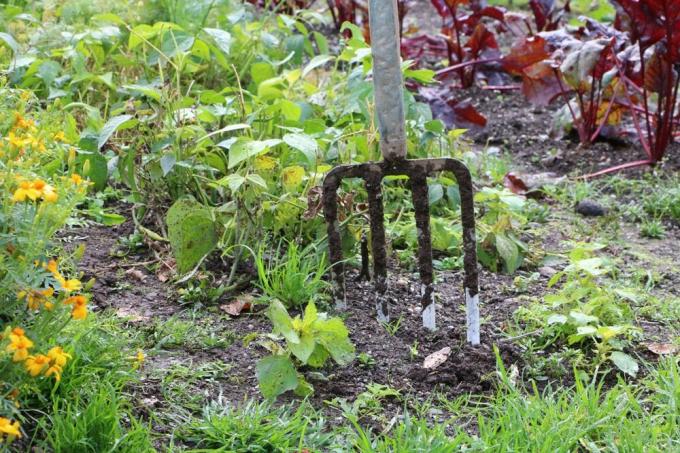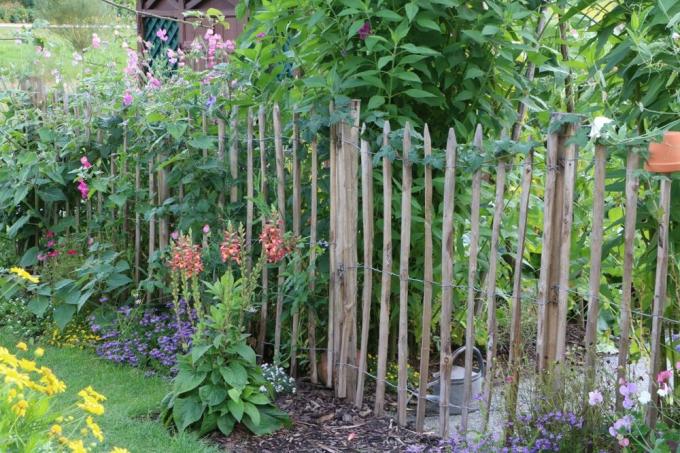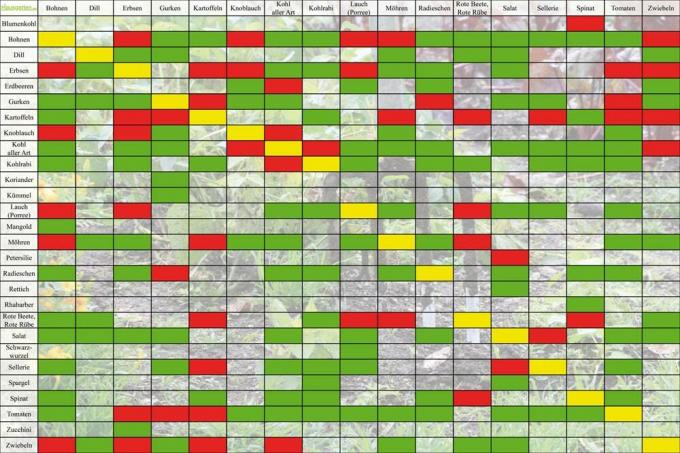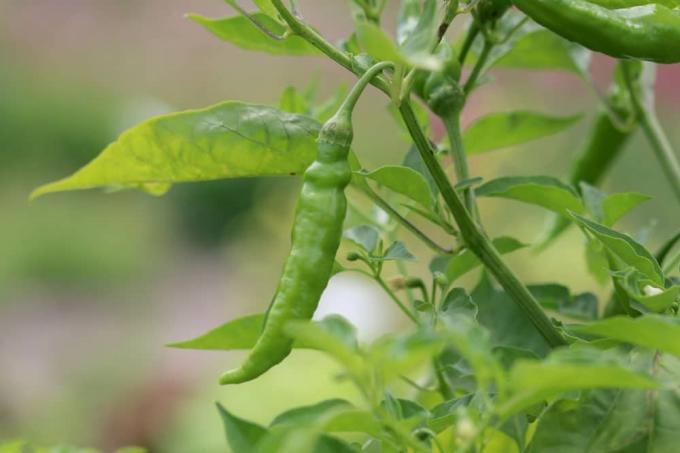

Table of contents
- What is a mixed culture? – A definition for practitioners
- Prerequisites for a successful mixed culture
- Examples of good neighborhoods
- Examples of bad neighborhoods
- Fatal plant communities
- Flowers and herbs for mixed culture
- flowers and perennials
- Herbs
- Practical example of a bed with fruit vegetables
- Conclusion
In untouched nature, plants of different genera and species band together to pool their defenses. With this strategy, flowers and perennials effectively fend off cunning pathogens and pests. Knowledgeable home gardeners take advantage of these floral coalitions by cultivating their vegetable garden in intercropping. This guide explains all the connections that define this technical term. Examples from daily practice in the garden illustrate which alliances in the plant kingdom work and which do not.
What is a mixed culture? – A definition for practitioners
The rule of thumb 'opposites attract' is more of a tongue-in-cheek hint for the human partner search. In the plant kingdom, however, this saying is based on solid experience acquired by generations of home gardeners. The knowledge gained is primarily used in the kitchen garden. Those who prefer cultivation according to ecological principles cultivate their vegetables in mixed cultures. What this is all about is summed up in the following definition:
Definition:
Mixed culture refers to the joint cultivation of different crops and ornamental plants that have a positive effect on each other in terms of growth, health and yield.
Specifically, this definition describes the fact that plants can support each other, despite different growth rates and divergent demands on the water and nutrient supply. Thanks to different rooting depths, plants in mixed cultures do not get in each other's enclosures. In this way, they make optimal use of local resources without leaching the soil. Thanks to their root exudates, escaping odors and root residues, ornamental and useful plants strengthen each other's defenses and bundle them against diseases and pests.
Conversely, the findings from the mixed culture mean that plants of the same botanical classification influence each other negatively. The negative effects against even so far that sometimes a year-long break in cultivation until, for example, brassicas or rhubarb are planted again at the previous location can. In commercial agriculture, the adverse effects of monoculture are offset by artificial fertilisers, pesticides and other methods that are harmful to health and the environment.
Are you wondering why monoculture still dominates in commercial agriculture?
This fact is undoubtedly due to the increased workload caused by the mixed culture. In addition, incorrect assessments in the planting plan can cause considerable problems if incompatible plant species are mistakenly placed next to each other in the bed.
Prerequisites for a successful mixed culture
Since the socialization of different plant species can have both positive and negative consequences, the successful mixed culture is subject to various criteria. Prudent planning primarily sets the course for a successful course. The planting plan aims to use the beneficial properties while excluding inhibiting factors. In addition to the attributes of the plants, other aspects come into focus that ensure a high-yield mixed culture. The following overview summarizes all important requirements:
- Exact research, which plants get along and which don't
- Select a location suitable for all intended plants
- Careful tillage including digging, weeding and organic nutrient supply
- sowing and planting at the right time; not too early and not too late
- Note growth height and do not socialize plants that shade each other

Home gardeners primarily use the mixed culture in order to be able to do without chemical pesticides and artificial fertilizers. Therefore, only organic fertilizers are used in the preparation and continuous care of the soil. With compost, horse manure, horn shavings and sand you can work wonders in improving the soil. Plant manure made from stinging nettles and comfrey also supplies the soil with nitrogen and fends off pathogens in the event of increased infestation pressure. With these ecological methods you strengthen the floral backing of your plants and optimize the conditions for a flourishing mixed culture.
Tip:
The mixed culture scores in the garden with a decorative advantage that provides floral moments of happiness throughout the growing season. The colorful dance of delicious vegetables, colorful summer flowers and opulent perennials transforms the kitchen garden into a decorative eye-catcher.
Examples of good neighborhoods
The classic for an advantageous mixed culture is the socialization of carrots and onions. Carrots protect their neighbors from the onion fly and onions repel the carrot fly. Another prime example are Imperial Crown and Spurge. Spurge root excretions have been shown to scare off voles that are after the bulb of a crown imperial. The following table provides you with tried and tested examples from the garden for a successful mixed culture:
- bush beans: broccoli, cucumbers, all types of cabbage, lettuce, kohlrabi, pumpkin, chard, radish, beetroot, rhubarb, celery and tomato
- Dill: Peas, cucumbers, lettuce, carrots, beets and onions
- Peas: broccoli, dill, cucumber, kohlrabi, all types of cabbage, carrots, radishes, lettuce, zucchini
- Cucumbers: broccoli, fava beans, dill, garlic, cabbage, coriander, lettuce, cumin
- potatoes: Broccoli, broad beans, kohlrabi and spinach
- Garlic: Strawberries, Cucumbers, pumpkin and carrots
- Cabbage of all kinds: French and pole beans, peas, cucumbers, leeks, carrots, radishes, lettuce, celery, spinach and tomatoes
- Kohlrabi: Beans, peas, potatoes, leeks, radishes, beets, celery, spinach, asparagus and tomatoes
- Lettuce: Beans, broccoli,, dill, peas, strawberries, cucumbers, cabbage, radish, radishes, asparagus, tomatoes and onions
- Leeks: Strawberries, cabbage, kohlrabi, carrots, salsify, lettuce, celery and tomatoes
- Carrots: dill, peas, garlic, leeks, radishes and tomatoes
- Radishes: Beans, peas, strawberries, all kinds of cabbage, kohlrabi, carrots, lettuce, spinach and tomatoes
- Celery: Beans, cucumbers, cabbages, kohlrabi, leeks and tomatoes
- Spinach: beans, potatoes, cabbage, radishes, rhubarb and tomatoes
- Beetroot: broccoli, French beans, dill, kohlrabi, onions
- tomatoes: Beans, broccoli, garlic, cabbage, leeks, carrots, all kinds of salads, radishes, celery and spinach
- Onions: Strawberries, cucumbers, carrots, kohlrabi and beets
For the cultivation of berry bushes, joint cultivation with broad beans, peas, garlic, mustard and French beans have proven to be beneficial. Blackberries harmonize perfectly with sweet lupins, blueberries favor the common yarrow as a neighbor and raspberries want to thrive alongside lamb's lettuce and garlic.
Examples of bad neighborhoods
Corresponding to the table with recommended plant neighbors, we do not want to deprive you of unsuitable partnerships:
- French beans: peas, garlic, leeks and onions
- Peas: French beans, garlic, leeks, tomatoes and onions
- cucumbers: potatoes, radishes and tomatoes
- Potatoes: Peas, cucumbers, beets, celery and especially tomatoes
- Garlic: French beans, peas, and most cabbages
- Cabbage of all kinds: strawberries, garlic, kohlrabi and onions
- Kohlrabi: all types of cabbage
- Lettuce: parsley and celery
- Leek (Leek): Beans, peas and beetroot
- Carrots: French and pole beans, potatoes and beetroot
- Radishes: cucumbers
- Celery: potatoes
- Spinach: cauliflower and beetroot
- Beetroot: spinach
- Tomatoes: peas, cucumbers and especially potatoes
- onions: French beans, peas and potatoes

Fatal plant communities
Various ornamental and useful plants of a genus are not well-disposed towards one another. Therefore, avoid a mixed culture with species of the following plant genera:
- Cruciferous vegetables: all types of cabbage, such as cauliflower, kale or Chinese cabbage, as well as cress, radishes, turnips or mustard
- Legumes: including beans, peas, lupins and vetches
- Umbellifers: for example dill, lovage, carrots, Parsely or celery
These genera are not only completely unsuitable for a mixed culture among themselves. In addition, a time interval in the cultivation is strongly recommended. After harvesting cauliflower, please wait at least 4 years before planting cabbage or any other cruciferous vegetable in the same spot. Otherwise, diseases such as the dreaded clubroot have an easy time.
Flowers and herbs for mixed culture
The following flowers and herbs promote the benefits of intercropping in several ways. With their pretty flowers, they embellish the kitchen garden or bring fresh herbs to the kitchen for the preparation of dishes. They also attract busy pollinators into the bed, loosen the soil with their roots, enrich the soil with nitrogen and ward off diseases and pests.
flowers and perennials
- Tagetes promote soil health
- Marigolds repel harmful nematodes, as well as wireworms and bean aphids
- Sweet lupins enrich the soil with nitrogen
- Purple bells and coneflowers repel snails
- Lily of the valley is said to have a healing effect against fruit rot and berry diseases
- Forget-me-not drives away the raspberry beetle and spoils the appetite of maggots
Herbs
- chives combats fungal infections such as gray mold with ethereal root excretions
- Chamomile improves resistance to fungal infections, repels leek moths, nematodes and thrips
- Nasturtium repels ants, lice, whiteflies and caterpillars
- Lavender protects against powdery mildew and aphids
- Thyme has a repellent effect against harmful insects, lice, cabbage whites, snails and deer
Some flowers and herbs are incorporated into the mixed culture planting plan to sacrifice them to protect vegetables. Nasturtium magnetically attracts voracious snails. Associated with cauliflower, Brussels sprouts, kale or lettuce, these vegetables are spared from the pests. The mixed culture with potatoes and horseradish is moving in a similar direction.
Practical example of a bed with fruit vegetables

The following example from the practical use of mixed cultures illustrates how you can actually implement the table in your garden. A bed 1.20 meters wide is planned for the cultivation of tomatoes and peppers as the main crop. The family would like fresh cut lettuce and crunchy radishes as side crops. A look at the table shows that these types of vegetables are compatible with each other. Here's how to do it sensibly throughout the year:
- Dig up the soil in the autumn of the previous year and work in 3-5 liters of compost per square meter
- Weed the bed in spring, rake it and divide it into 4 main rows
- Sow spinach in all rows between mid-March and early April or plant early young plants
- At the end of April, sow radish, lettuce and garden cress seeds between the main rows
- After about 6 weeks, harvest radishes, lettuce and cress when spinach takes up more space
- Tear out all the spinach leaves in mid-May
- Plant tomatoes in the two middle rows
- In the two outer rows paprika and put pepperoni
- Sow marigolds and marigolds between the main rows
When the temperatures fall below 15 degrees Celsius in autumn, the time window for harvesting tomatoes, peppers and peppers closes. You can harvest unripe fruit and let it ripen indoors. If the plant remains in the bed have died, they are removed and disposed of in the compost. Weather permitting, now is the best time to prepare the soil for next year with a hardy green manure.
Conclusion
Mixed culture is one of the mainstays for near-natural cultivation in private kitchen gardens. This concept is based on the wealth of experience that home gardeners have accumulated over generations. In concrete terms, vegetable plants of different genera and species are socialized in a bed in order to mutually promote growth, health and profitability. Conversely, since there are also unfavorable neighborhoods in the plant kingdom, the planting plan requires precise knowledge of compatibility and intolerance. The examples listed here with a table provide concrete assistance for the successful implementation of a mixed culture in your vegetable garden.
 garden editorial
garden editorial I write about everything that interests me in my garden.
Learn more about maintaining a vegetable garden

Make a climbing aid for cucumbers yourself: building instructions
Cucumbers are healthy, tasty and versatile. In order for the cultivation in your own garden to be successful, you should offer the cucumber tendril, which likes to climb, optimal conditions. The easiest way to do this is with a cucumber trellis, which you can quickly and easily build yourself with our instructions.

Pricking out vegetables: Information for vegetable plants such as spinach, corn & Co
Many gardeners prefer their vegetables on the windowsill or in the greenhouse in the spring. After some time, the seedlings must be isolated by pricking out. This measure is essential for their survival so that they can develop healthily and vigorously.

Growing vegetables in the garden – which vegetables to plant next to each other?
Today, even a hobby gardener knows: With the right neighbors, vegetable plants develop particularly well in mixed cultures. You can even defend yourself against pests together. In this article we have put together for you which types of vegetables go well together and which go poorly together.

Sowing calendar for vegetables - when to sow which vegetables?
With so many different types of vegetables, it is not easy to find the right time for sowing. Finally, the appointment differs depending on the species. In addition, of course, it also makes a difference whether the vegetables are pre-cultivated in the house, cold frame or greenhouse or sown straight into the field.

Growing pepperoni plants from seed - instructions to harvest
The cultivation of the crunchy peppers is extremely popular among many hobby gardeners. rightly so! - Because the colorful fruits of the pepperoni plants not only beautify the vegetable patch, but are also extremely tasty. If you also prefer rare or special types of pepper, you can prefer them yourself with a comparatively small amount of work.

Eat vegetables - information for peppers, physalis, cucumbers & Co
Eat vegetables or not - opinions differ here. The care measure should direct the energy of the plants to the development of fruit and thereby increase the yield. There is no scientific evidence for this, but convincing experience. The right approach is important when it comes to exhaustion, the appropriate instructions can be found here.



